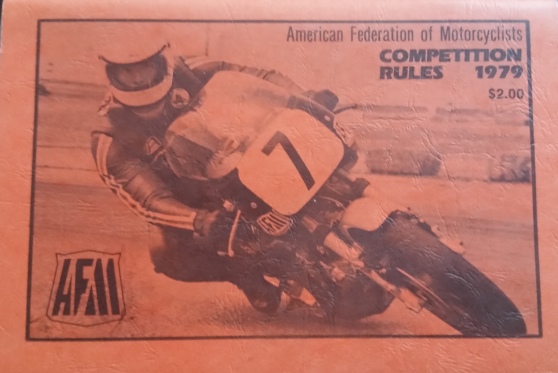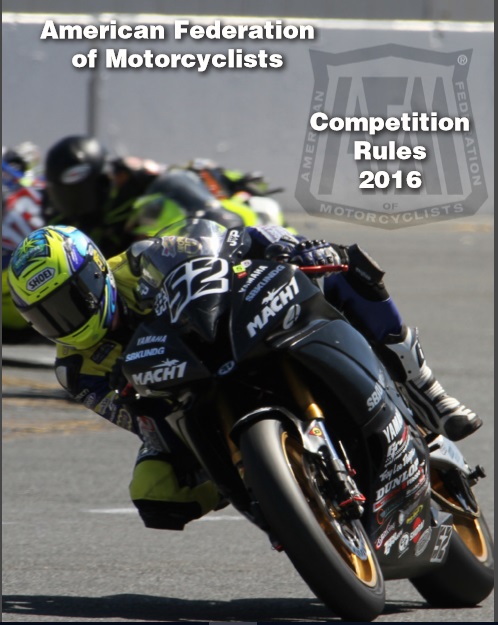This is based on an idea from Chuck McAvoy. Thanks Chuck!

AFM Rule Book for 1979 (yes it had an orange cover, and yes that’s me).
I don’t completely trust my memory so I dug out the American Federation of Motorcyclists (AFM) rule book for 1979. As you would expect, it has a bunch of rules that apply to all riders and motorcycles, then defines the racing classes. In 1979 we had five categories of classes: Gran Prix, Production, Super Street, Box Stock, and Sidecar. Within these categories were classes based on engine displacement (except for sidecar, which was a single class with no displacement limit).
Box Stock was literally “off the showroom floor.” Very few modifications were allowed. You could change tires (DOT approved) and brake pads. You could change front and rear sprockets to alter gearing. Rear shocks could be changed provided they were the same length as original and used the same mounting points. Things like mirrors, turn signals, side and center stands had to be removed. That’s it. You couldn’t touch the engine or the frame, and all the original bodywork had to be there. There were four box stock classes, up to 410cc, 411cc-550cc, 551cc-750cc, and Open.
Super Street was for bikes that had been modified so they weren’t legal for the Production class but were still street legal. A good example of that would be an aftermarket exhaust — Production rules required stock exhausts. There were two Super Street classes, up to 600cc and 601cc and above.
GP Classes were pretty much anything with two in-line wheels. The bikes were pukka race bikes like the Yamaha TZ250 or street bikes modified so they were no longer street-legal. There were eight GP classes: 50cc, 100cc, 125cc, 200cc, 250cc, 500cc, and Open. There had once been a 350cc class but it was gone by 1979. Instead there was an exception for the 250cc GP class: If it wasn’t a multi-cylinder two-stroke the limit was 360cc.
Production Classes were, more or less, silhouette classes. The bikes had to look like the ones the dealers sold, so you needed to use the stock seat, fuel tank, wheels, handlebar mounts, engine castings, foot control mount points, mufflers, etc. You could re-jet the carbs but they had to be stock make and throat size. You could do almost anything inside the motor as long as you stayed within the class displacement and kept he stock stroke. For example the original Honda CB750 had an actual displacement of 736cc, and it was legal to bore it out to a full 750ccs. Cams, pistons, clutch plates, porting, etc. could be changed. Racing tires, including slicks, were allowed. The size of the wheels could be changed but they had to be the same type, spokes or cast, as sold. You needed to use the stock battery charging system. The production classes were 125cc, 200cc, 250cc, 410cc, 550cc, 750cc and Open.
To summarize, there were 21 AFM classes in 1979:
Sidecar: one class.
Box Stock: 410cc, 550cc, 750cc, Open.
Super Street: 600cc, Open.
Production: 125cc, 200cc, 250cc, 410cc, 550cc, 750cc and Open.
Gran Prix: 50cc, 100cc, 125cc, 200cc, 250cc, 500cc, and Open.
Now let’s take a look at AFM’s classes today. This is info from their rule book which I downloaded from the web site, afmracing.org. Today’s AFM class structure for their GP classes is pretty complicated. I’ve simplified some in places – you can download the rule book if you want all the details.

AFM Rule Book for 2016 has a color cover.
There are three major groups of classes; GP, Superbike, and Production. There are also three “Clubman” classes for first-time racers and, well, slowpokes; and an AFemme class for women. Once a rider was up to speed they could enter any of the other classes.
Gran Prix (GP)
There are 13 GP Classes. Five of them are performance equalization formulae, allowing very different bikes with similar power potential to race against each other. Here’s one example.
Formula IV:
250-700 cc 4-stroke twin-cylinder, plus Yamaha FZ07.
250-450 cc 4-stroke multi-cylinder.
201-250 cc Street based, 2-stroke, twin-cylinder.
500-0pen cc 4-stroke, single cylinder.
251-810 cc 4-stroke, 2-valve, air-cooled twins.
251-1050 cc 4-stroke, push-rod, 2-valve, air-cooled twins.
1200 cc 4-stroke, push-rod, 2-valve, air-cooled twins that comply with the AMA Pro Racing XR1200 Race Series Rules.
To an old timer like me this is amazing. A Kawasaki KLR650 vs. a race prepped Harley XR1200 vs. a Suzuki SV650 vs. a Yamaha FZ07 vs. an old Yamaha RD250 vs. a Ducati with the 750 cc desmodue motor. Wouldn’t that be entertaining?
There are formula classes that allow bikes a small as 100cc to compete (F-II), and an “Open GP” class for the big bikes. In addition to the power-equalization classes there are some specialty classes within the GP category. For example,
Formula Singles: 245-Open cc 4-stroke single cylinder, naturally aspirated.
Formula 40: (3 classes) for riders who are 40 years old or older.
Formula 50: for riders who are 50 years of age or older.
Formula Pacific: A special class for the fastest riders. No displacement requirements. At Sonoma, riders must achieve a consistent lap time of 1:47.0 to enter; at Thunderhill, 1:59.0; at Buttonwillow, 1:56.0 (1:59.0 counter clockwise). If a rider appears they will be lapped before the end of the race they may be black-flagged. Riders may be required to prove lap time eligibility from official AFM time charts.
Formula Vintage: For 1982 and earlier motorcycles and like (i.e., the Yamaha Seca XJ550 was originally introduced in 1981, but was produced through 1983. The ‘83 model would be allowed); using DOT tires, with period modifications only. Vintage will be scored as one class (no displacement breakdowns).
SUPERBIKE
Superbike classes are based on engine displacement. Each of the following displacement categories is a class:
175-250 cc
251-450 cc
451-600 cc
601-750 cc
751-Open cc
In addition to these displacement classes the “Superbike” group includes these special classes:
Super Dinosaur: No displacement limits; bikes must be model year 2001 and older.
Legacy (Models 2007 and earlier): Four classes.
PRODUCTION:
The Production classes are similarly displacement based. Each of the following displacement categories is a class:
175-250cc
251-350cc
351–450cc
451-600cc
600-700cc twin cylinder motorcycles
601-750cc
751-0pen
So what makes a bike a Superbike, a Production, or a GP bike? Like the 1979 rule book, the 2016 rule book contains a bunch of standard racing stuff that is required of all bikes ad riders, then defines classes in the three categories.
Section 9.1 defines the requirements for Production, and it has five pages of text telling what changes are allowed and what are not. Compared to my day there are a lot more after-market products allowed on the outside, but a lot fewer modifications allowed inside the engine.
Section 9.2 describes Superbikes. It is less than a page long. As I read it, you start with a street bike produced for general sale, and you have to keep the original frame and engine castings. Other than that it’s wide open.
The GP bike definition is even shorter. Mostly it describes how the fairing has to fit on the bike – no dustbin style fairings.
To summarize:
Formula/GP: F-IV, F-III, F-II, F-I, Open GP, F-Singles, F-Twins, F-40 Light, F-40 Middle, F-40 Heavy, F-50, F-Pacific, F-Vintage.
Superbike: 250cc, 450cc, 600cc, 750cc, Open, Super Dinosaur, Legacy-250, Legacy-Light, Legacy-Middle, Legacy-Heavy.
Production: 250cc, 350cc, 450cc, 600cc, 700cc Twins, 750cc, 0pen.
Other: Clubman-Light, Clubman-Middle, Clubman-Heavy, AFemme, Electric.
This is up to 35 classes at each race meet! No wonder AFM events are two days now; in my time it all happened in a day.
So, does anyone know how the AFM got from 21 displacement-based classes in 1979 to over 30 classes, including some rather creative Formula classes? It couldn’t have happened overnight. You can see a glimmer of a performance-equalization formula in 1979 with the 250cc GP class, but there must have been some sort of evolution to it over several years, maybe even a decade or two. Wouldn’t that be an interesting story?